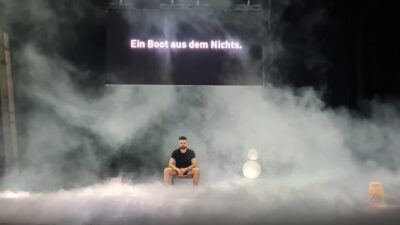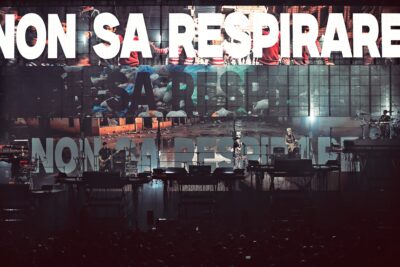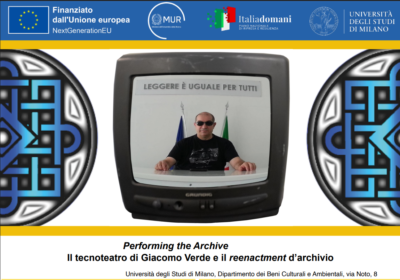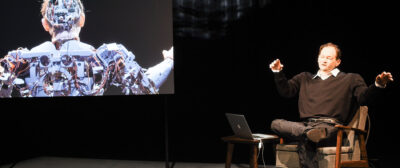By Helgard Haug
What if everything falters? What if it cannot go any further?
In March 2021, the 400-metre-long and almost 60-metre-wide container ship Ever Given ran aground on an embankment of the Suez Canal in strong winds. It capsized – blocking global freight transport and world trade for six days. More than 400 ships were jammed on both sides of the canal far into the Mediterranean and Red Sea. A central trade route froze. Was the Ever Given, with a dead weight of 220,000 tonnes plus 20,000 containers, simply too heavy? Or too big? Because in terms of length, it can almost match the height of the Empire State Building. Was there too much to be transported too quickly in order to maximise profits?
EVER GIVEN is focusing on collapse. What if a person, an organism, an entire system can no longer continue as before? What if everything that previously seemed self-evident is suddenly disrupted? What happens during a standstill? The protagonists on stage are people who have experienced or sought a radical rupture – were confronted with a message, a stroke of fate, a diagnosis. With a nothing-goes-anymore! But every crisis also has an opportunity somewhere, which in retrospect is often seen as an important turning point, as a moment of solidarity and collaboration.
E se tutto vacillasse? E se non potesse andare oltre?
Nel marzo 2021, la nave portacontainer Ever Given, lunga 400 metri e larga quasi 60, si è arenata su un argine del Canale di Suez a causa del forte vento. Si è ribaltata, bloccando il trasporto merci e il commercio mondiale per sei giorni. Più di 400 navi sono rimaste bloccate su entrambi i lati del canale, fino al Mediterraneo e al Mar Rosso. Una via commerciale centrale si bloccò. La Ever Given, con un peso morto di 220.000 tonnellate più 20.000 container, era semplicemente troppo pesante? O troppo grande? Perché in termini di lunghezza può quasi eguagliare l’altezza dell’Empire State Building. C’era troppo da trasportare troppo velocemente per massimizzare i profitti?
EVER GIVEN si concentra sul collasso. Cosa succede se una persona, un organismo, un intero sistema non può più continuare come prima? Cosa succede se tutto ciò che prima sembrava evidente viene improvvisamente interrotto? Cosa succede durante un arresto? I protagonisti in scena sono persone che hanno vissuto o cercato una rottura radicale – sono stati messi di fronte a un messaggio, a un colpo di fortuna, a una diagnosi. Con un nulla di fatto! Ma ogni crisi ha anche un’opportunità da qualche parte, che a posteriori viene spesso vista come un importante punto di svolta, come un momento di solidarietà e collaborazione.
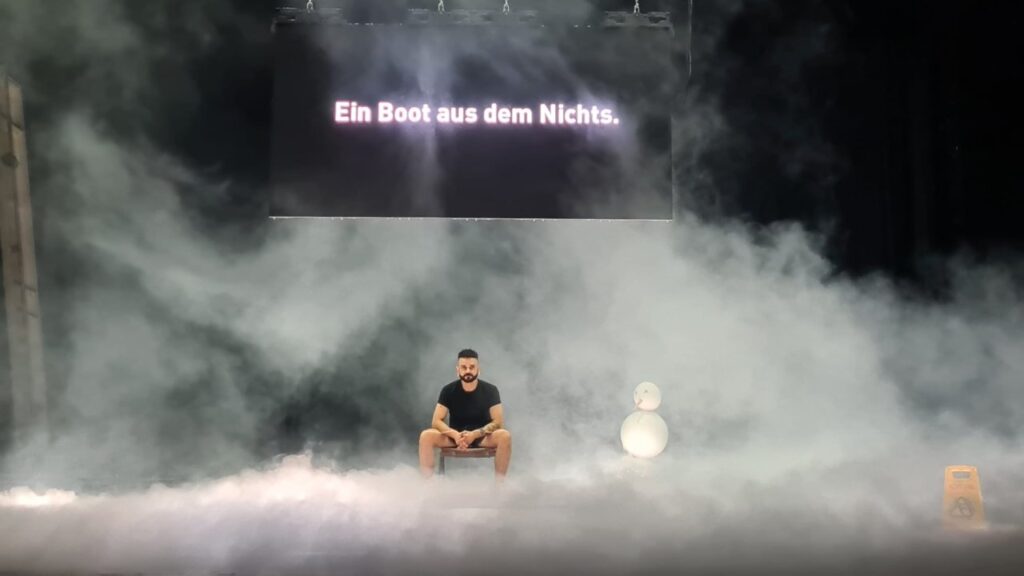
With: Adham El Said, Hana Hazem, Michaela Groch-Fischer, LED and Marianne Vlaschits
Concept, text, direction: Helgard Haug
Composition: Barbara Morgenstern
Live music: Barbara Morgenstern, Daniel Eichholz
Sound design (live): Peter Breitenbach
Stage design and Costume: Evi Bauer
Video art and Lighting design: Marc Jungreithmeier
Dramaturgy: Maria Nübling, Henning Nass
Assistant director: Birgit Allesch
Assistant stage designer: Laura Schroeder
Artistic collaboration: Lisa Homburger
Intership: Noémi Juniki, Güde Nissen
Production management: Maitén Arns, Eva Luzia Preindl
Tour management: Chloé Ferro
Technische Leitung Rimini Protokoll: Patrick Tucholski
Container ship video-footage: Christoph Schwarz
(„Supercargo“ www.christophschwarz.net/supercargo)
A production of Volkstheater Wien and Rimini Apparat in co-production with HAU Hebbel am Ufer and Theater Magdeburg.
Vienna, Volksthetaer
13. – 14.12.2024
Vienna, Volkstheater
25. – 26.01.2025
Vienna, Volkstheater
01. – 03.03.2025
Supported by the German Federal Cultural Foundation. Funded by the Federal Government Commissioner for Culture and the Media.

